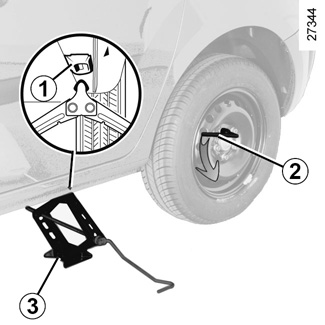CHANGING A WHEEL

Vehicles equipped with a jack and wheelbrace
If necessary, remove the wheel trim.
Use the wheelbrace to slacken off the wheel bolts 2. Position it so as to be able to push from above.
Crank up jack 3 by hand to position the jack head against the jacking point closest to the relevant wheel and marked by an arrow 1.
Continue to crank the jack so that the baseplate is correctly positioned (it should be underneath the vehicle and aligned with the jack head).
Turn it a few times to lift the wheel off the ground.
Switch on the hazard warning lights.
Keep the vehicle away from traffic and on a level surface where it will not slip.
Apply the parking brake and engage a gear (first or reverse, or P for automatic transmissions).
Ask all the passengers to leave the vehicle and keep them away from traffic.
If the vehicle is parked on the hard shoulder, you must warn other road users of your vehicle’s presence with a warning triangle or with other devices as per the legislation applying to the country you are in.
To prevent any risk of injury or damage to the vehicle, raise the jack until the wheel you are replacing is a maximum of 3 centimetres off the ground.
Undo the bolts and take off the wheel. For vehicles fitted with alloy wheels, use the guide bolt located in the tool kit to finish loosening and start tightening the bolts.
Fit the emergency spare wheel on the central hub and turn it to align the mounting holes in the wheel and the hub.
Tighten the bolts, checking that the wheel is correctly positioned on its hub.
Lower the jack.
If bolts are supplied with the emergency spare wheel, only use these bolts for the emergency spare wheel.
With the wheel on the ground, tighten the bolts fully and have the tightness of the bolts checked and the emergency spare wheel pressure checked as soon as possible.
Anti-theft bolts
If you use anti-theft bolts, fit these nearest the valve (wheel trim may not be able to fit).
Vehicle fitted with a tyre pressure loss warning system
If under-inflated (puncture, low pressure, etc.), the warning light lights up on the instrument panel. See “Tyre pressure loss warning” in Section 2.
If you have a puncture, replace the wheel as soon as possible.
A tyre which has been punctured should always be inspected (and repaired, where possible) by a specialist.